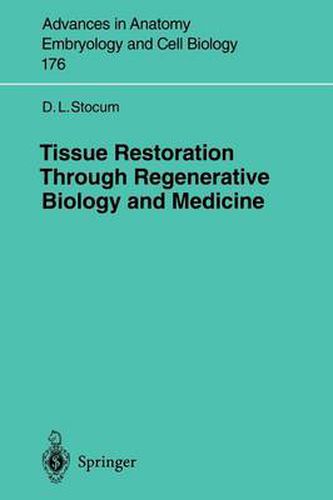Readings Newsletter
Become a Readings Member to make your shopping experience even easier.
Sign in or sign up for free!
You’re not far away from qualifying for FREE standard shipping within Australia
You’ve qualified for FREE standard shipping within Australia
The cart is loading…






This title is printed to order. This book may have been self-published. If so, we cannot guarantee the quality of the content. In the main most books will have gone through the editing process however some may not. We therefore suggest that you be aware of this before ordering this book. If in doubt check either the author or publisher’s details as we are unable to accept any returns unless they are faulty. Please contact us if you have any questions.
Advances in cell, developmental and molecular biology, and the discovery of regeneration-competent cells in many non-regenerating mammalian tissues, have given impetus to systematic investigations that will enable us to regenerate these tissues by cell transplantation or the pharmaceutical induction of regeneration from the body’s own tissues. A significant avenue of research is the identification of the soluble and insoluble signals and their transduction pathways that govern the proliferation and differentiation of regeneration-competent cells, and the signals that inhibit their activity after injury. How far can we go in our quest for regeneration? We will probably be able to induce the regeneration of some tissues, such as skin or even spinal cord, within a few years. The regeneration of others, such as heart, lung, kidney or appendages, may be more complex and difficult, but we should not view them as impossible. They will just take a little longer.
$9.00 standard shipping within Australia
FREE standard shipping within Australia for orders over $100.00
Express & International shipping calculated at checkout
This title is printed to order. This book may have been self-published. If so, we cannot guarantee the quality of the content. In the main most books will have gone through the editing process however some may not. We therefore suggest that you be aware of this before ordering this book. If in doubt check either the author or publisher’s details as we are unable to accept any returns unless they are faulty. Please contact us if you have any questions.
Advances in cell, developmental and molecular biology, and the discovery of regeneration-competent cells in many non-regenerating mammalian tissues, have given impetus to systematic investigations that will enable us to regenerate these tissues by cell transplantation or the pharmaceutical induction of regeneration from the body’s own tissues. A significant avenue of research is the identification of the soluble and insoluble signals and their transduction pathways that govern the proliferation and differentiation of regeneration-competent cells, and the signals that inhibit their activity after injury. How far can we go in our quest for regeneration? We will probably be able to induce the regeneration of some tissues, such as skin or even spinal cord, within a few years. The regeneration of others, such as heart, lung, kidney or appendages, may be more complex and difficult, but we should not view them as impossible. They will just take a little longer.